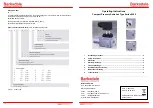
logical network, it contains its own bridge Management Information Base (MIB) information and can support
its own implementation of spanning tree.
Figure 1: VLANs as Logically Defined Networks
VLANs are often associated with IP subnetworks. For example, all the end stations in a particular IP subnet
belong to the same VLAN. Interface VLAN membership on the switch is assigned manually on an
interface-by-interface basis. When you assign switch interfaces to VLANs by using this method, it is known
as interface-based, or static, VLAN membership.
Traffic between VLANs must be routed .
The switch can route traffic between VLANs by using switch virtual interfaces (SVIs). An SVI must be
explicitly configured and assigned an IP address to route traffic between VLANs.
Supported VLANs
The switch supports VLANs in VTP client, server, and transparent modes. VLANs are identified by a number
from 1 to 4094. VLAN 1 is the default VLAN and is created during system initialization. VLAN IDs 1002
through 1005 are reserved for Token Ring and FDDI VLANs. All of the VLANs except 1002 to 1005 are
available for user configuration.
There are 3 VTP versions. VTP version 1 and version 2 support only normal-range VLANs (VLAN IDs 1 to
1005). In these versions, the switch must be in VTP transparent mode when you create VLAN IDs from 1006
to 4094. VTP version 3 supports the entire VLAN range (VLANs 1 to 4094). Extended range VLANs (VLANs
1006 to 4094) are supported only in VTP version 3. You cannot convert from VTP version 3 to VTP version
2 if extended VLANs are configured in the domain.
You can configure up to 4094 VLANs on the switch.
Consolidated Platform Configuration Guide, Cisco IOS XE Release 3SE (Catalyst 3850 Switches)
OL-29322-01
3
Configuring VLANs
Supported VLANs




































